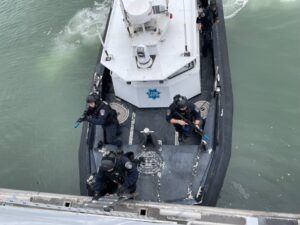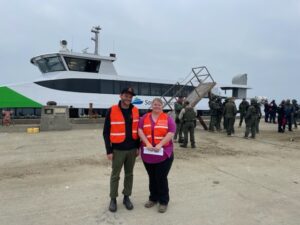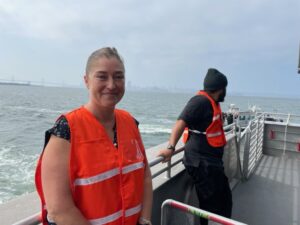BY STAS MARGARONIS
On September 20th, the Golden Gate Bridge, Highway, & Transportation District coordinated a series of exercises in which law enforcement agencies from around the San Francisco Bay practiced boarding a ferry in open water as part of an exercise to disarm an active shooter terrorizing passengers.
The ferry was sailing in the San Francisco Bay at the time of the exercise.
Brandon Chapman, Security and Emergency Management Specialist, Golden Gate Bridge, Highway, & Transportation District said that the District was coordinating its “Bay Ferry 6 Full Scale Emergency Exercise.”
Chapman said that as part of a 4-day event, participants exercised and tested the concept of an “Operations for an Active Threat Onboard a Passenger Vessel in the Bay Area.”
Brandon Chapman and maritime incident observer Benita Margaronis
The events included:
- Monday September 18thPreventive Radiological/Nuclear Detection
- Tuesday September 19thActive Shooter/Threat on a Dock Ferry
- Wednesday September 20thActive Shooter on a Commuter Ferry Underway
- Thursday September 21stIED Detonation on a Commuter Ferry/Vessel Mutual Assistant Plan
ACTIVE SHOOTER EXERCISE
Before the active shooter exercise began, Chapman said:
“Today is Day 3 of the San Francisco Bay Ferry exercise … So, there are two situations. They’re both active shooters with several hostage situations on one boat. And another boat is active shooters with passengers injured … onboard the boat and deceased.
The law enforcement teams must find if there is any IEDs (Improvised Explosive Device) on board. So explosive devices. This is a multiple jurisdictional exercise because the ferries are underway. So, the plan is this ferry is coming from Vallejo and going to China Basin at the Oracle (Baseball) Park Ferry terminal when the active shooter situation presents itself. “
At the point when the shooter threatens passengers, the vessel’s master “coordinates with the Coast Guard for a response and then the Coast Guard … puts out … the alert for the I.O.C. (Integrated Operations Command) that provides a response from federal, state and local law enforcement and other agencies. The Coast Guard runs a 24/7 operations center … at the Yerba Buena Island command post for Sector San Francisco. They put out the alert and then all the marine units respond to the stricken ferry to help. That’s what we’re testing today.”
During the exercise, law enforcement units from various cities and counties dispatched teams and vessels to the ferry. They secured access to the ferry main deck by a ladder. Officers climbed up the ladder, boarded the ferry and then searched and neutralized an active shooter. During the exercise several actors portrayed wounded passengers who had to be treated by law enforcement teams.
TRAINING LAW ENFORCEMENT ON FERRY BOARDINGS
The practice aided law enforcement personnel in handling their vessels, expeditiously bringing them alongside the ferry, making sure officers could secure the ladder to the ferry even in unstable conditions, and challenging officers armed with rifles to climb up the ladder in a rocky sea state.
During the exercise, a police coordinator debriefed law enforcement teams following the boarding and securing of the ferry from the shooter threat. The coordinator urged officers to listen to ferry passengers so as to secure intelligence about the shooter’s whereabouts and identity.
Actors playing passengers begged for help from wounds, but officers are trained to focus on securing the vessel first before providing aid.
An observer said that each team had officers trained with medical skills to provide preliminary first aid to the wounded. He said some teams placed more emphasis on ensuring their officers had medical skills.
Lauren Gularte, Government & Regulatory Affairs Manager, Water Emergency Transportation Authority (WETA) based in San Francisco said that WETA “is the agency that operates San Francisco Bay Ferry Services and I manage our emergency response program.”
Lauren Gularte
She said: “This scenario here (active shooter exercise) today is an active threat scenario (that) would be a little bit different from the type of emergencies we normally deal with.”
EARTHQUAKE EMERGENCY
Gularte said that in the case of an earthquake, where the integrity of transportation by the bridges in the Bay was in question, “we do have plans to move people who are stranded “on either side of San Francisco Bay.”
She said that: “But based on some calculations that we’ve done a couple years ago, really the land side is the limiting factor. We have enough vessels, we need more terminal space and docking space to offload those vessels faster so that we can go back and forth. We did some ballpark estimates a couple of years ago, and we were able to move with all the assets in the Bay … I think it was 250,000 people (moved) within a 24-to-28-hour period … That’s the rosiest picture.”
Gularte said WETA is designated by the California Legislature to provide emergency ferry service for passengers, not cargo, “during some kind of incident that incapacitates the regional transportation system… focuses on vessels that have a hundred passenger capacity … we have 17 vessels in our fleet. Now we have three more vessels coming in about year and a half … In the future, all ferries will be electric vessels.”
On its website, WETA says it is “a regional public transit agency tasked with operating and expanding ferry service on the San Francisco Bay and with coordinating the water transit response to regional emergencies. Under the San Francisco Bay Ferry brand, WETA carries over three million passengers annually utilizing a fleet of … high speed passenger-only ferry vessels. San Francisco Bay Ferry currently serves the cities of Alameda, Oakland, Richmond, San Francisco, South San Francisco, and Vallejo.”
WETA “is the administrative agency … We work with a private ferry operator to crew, maintain and operate our vessels. That ferry operator has six large capacity vessels that we use … for our emergency response mandate. We have a mutual aid agreement with the other public ferry operator on the Bay, which is Golden Gate … They have six very high-capacity vessels as well. And then we work very closely with the private ferry operators around the region.”




